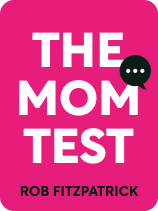

This article is an excerpt from the Shortform book guide to "The Mom Test" by Rob Fitzpatrick. Shortform has the world's best summaries and analyses of books you should be reading.
Like this article? Sign up for a free trial here.
How can you use customer conversations to make your product better? What information should you gather during these discussions?
In The Mom Test, Rob Fitzpatrick recommends taking customer feedback to determine if your business is worth continuing. To get this feedback, you need to talk with customers in the first place.
Keep reading to learn how to take advantage of your customer conversations.
Use Customer Conversations to Gather Information
Before investing money and effort into developing your idea for a product or service, Fitzpatrick recommends taking time to interview potential customers to determine if your idea is viable and discover how to improve it. This stage of seeking out customer conversations full-time should take no more than a week or two.
(Shortform note: If you take more than a week or two in this stage before taking action and beginning to develop your product, you may be using information-gathering as an excuse to procrastinate. In Procrastination, psychologists Lenora Yuen and Jane Burka explain that the root of all procrastination is fear of action—so if you find yourself in this situation, do some digging to discover why you’re afraid to develop your product. You may be afraid of failure, imperfection, or even success.)
We can describe this information-gathering process in four steps:
- Step #1: Choose your customer segment.
- Step #2: Settle on three learning objectives.
- Step #3: Seek informal conversations.
- Step #4: If necessary, schedule formal meetings.
Step #1: Choose Your Customer Segment
First, Fitzpatrick recommends identifying the customer segment you’d like to target with your business. In other words, identify a specific set of potential customers that share similar goals and problems. By narrowing in on the group you want to serve before seeking feedback, you can tailor your product precisely to that group’s needs. On the other hand, if you fail to identify a narrow enough customer segment, you’ll get contradictory feedback from people with different goals and problems and end up with a product that no one segment loves.
(Shortform note: In Purple Cow, Seth Godin echoes Fitzpatrick’s advice to target your product to a narrow customer segment, and he elaborates that this advice is especially applicable in today’s world. In the past, mass marketing was king—there were so few mass-produced products available that you could be successful by creating a product for everyone and advertising it to everyone. However, in the Internet Age, most markets are saturated with countless competitors, so the only products that succeed are those that do something remarkable for a niche group. Ideally, this niche group will then tell others about your remarkable product, turning your business into an industry leader.)
To narrow down a customer segment that’s too wide, Fitzpatrick recommends asking yourself questions to divide that group into subsets. For example, if your initial target demographic for your e-reader is “everyone who reads,” you can narrow this down by asking yourself questions like “What groups of people read the most?” or “What kinds of readers spend the most money?”
You’ll know your subsets are specific enough when you have a clear idea of where to find customers to interview for feedback. For example, you may decide to design your e-reader for people who work from home and want to read more but are struggling to quit the habit of mindlessly scrolling through their phones. In this case, you could find a company that uses remote workers and reach out to all of its employees via email.
(Shortform note: If you work at an already established company, narrowing down your customer segment is even easier than the process Fitzpatrick describes. In New Sales. Simplified., Mike Weinberg suggests simply identifying your best customers and seeking out others who fit that same demographic. You’ll already know where to find these new customers: presumably, the same place you found your existing superstar customers.)
Step #2: Settle on Three Learning Objectives for Your Conversation
Once you’ve chosen a target audience, Fitzpatrick advises identifying the three most important things you’d like to learn by talking to these customers. Use these objectives to keep your conversations focused. For example, if you’re planning to sell e-readers, your three learning objectives may be to 1) find out if customers really are dissatisfied with the way they currently read books, 2) figure out what has kept them from buying an e-reader in the past, and 3) discover what is motivating your customers to read books in the first place.
As you gather information from your potential customers, you’ll need to continuously update your learning objectives. Adjust your learning goals to fill gaps in your knowledge until you fully understand your customers’ motivations, problems, and daily routines.
How to Choose Learning Objectives: Seek Disappointment
How do you know which learning objectives to set? According to Fitzpatrick, the most important thing to keep in mind is to seek disappointment. The most valuable customer feedback you can receive is bad news that highlights the flaws in your business. The earlier you can pinpoint these flaws, the fewer resources you waste by investing in flawed ideas. Thus, aim your learning objectives at the weakest and riskiest parts of your business.
For example, if you’re looking to sell e-readers, you may be tempted to set learning objectives that have no chance of disappointing you: You may want to learn how readers typically motivate themselves to read, or what features the customer would want in their ideal e-reader. In contrast, if you set the objective “find out if customers really are dissatisfied with the way they currently read books,” you may discover that no one really wants a fancy e-reader and your business idea is hopeless. However, it would be better to learn this before you build your business rather than after.
(Shortform note: In The Subtle Art of Not Giving a F*ck, Mark Manson takes this idea further, arguing that as well as seeking information to disprove your assumptions about your business, you should also seek information that disproves all your beliefs. While giving up the beliefs you hold tightly can be scary, it’s necessary for the same reason that seeking disappointment in business is necessary: It’s better to learn that you’re wrong and start over than to waste time investing in flawed ideas. For instance, if you believe that money is the key to happiness, it’s better to find information that disproves that belief and have a temporary identity crisis than to spend your entire life chasing higher salaries and making yourself miserable.)
Step #3: Seek Informal Conversations With Potential Customers
When the time comes to learn from customer conversations, Fitzpatrick recommends sticking to informal conversations rather than official meetings. Customers are more likely to open up about their lives if they don’t feel pressured to give high-quality feedback. As mentioned above, in a casual setting, they often won’t know you’re conducting market research at all—they’ll just think you’re interested in their lives.
You can have informal feedback conversations anywhere—at the office water cooler, at a family reunion, or waiting for the bus. If you have your three learning objectives already in mind, you’ll be ready to learn from potential customers anytime. The vast majority of these conversations will take less than 15 minutes, making them far more efficient than scheduled business meetings.
Step #4: If Necessary, Schedule Formal Meetings
If you’ve chosen to sell to specialized professionals in an established industry (people you wouldn’t ordinarily cross paths with), you may need to schedule formal meetings to gather information in conversations with customers. In formal meetings, Fitzpatrick mandates making clear that you’re seeking details about the customer’s life and nothing more. Otherwise, you risk the customer assuming that it’s a sales meeting, which puts focus on you and your business rather than them and their needs and goals.
To schedule formal meetings with specialized professionals without any personal connections in the industry, you might try cold calling—contacting strangers in your customer segment out of the blue. While Fitzpatrick acknowledges that cold calls can be nerve-wracking and frustrating, he says not to get discouraged by frequent rejection. If you find just one or two good leads, you can often leverage those into further connections by asking for introductions to these professionals’ business networks.

———End of Preview———
Like what you just read? Read the rest of the world's best book summary and analysis of Rob Fitzpatrick's "The Mom Test" at Shortform.
Here's what you'll find in our full The Mom Test summary:
- How to ask the right questions to receive brutal honesty from anyone—even your mom
- How to use the “Mom Test” to gather objective feedback about your business or product
- How to extract the most important information from feedback conversations






